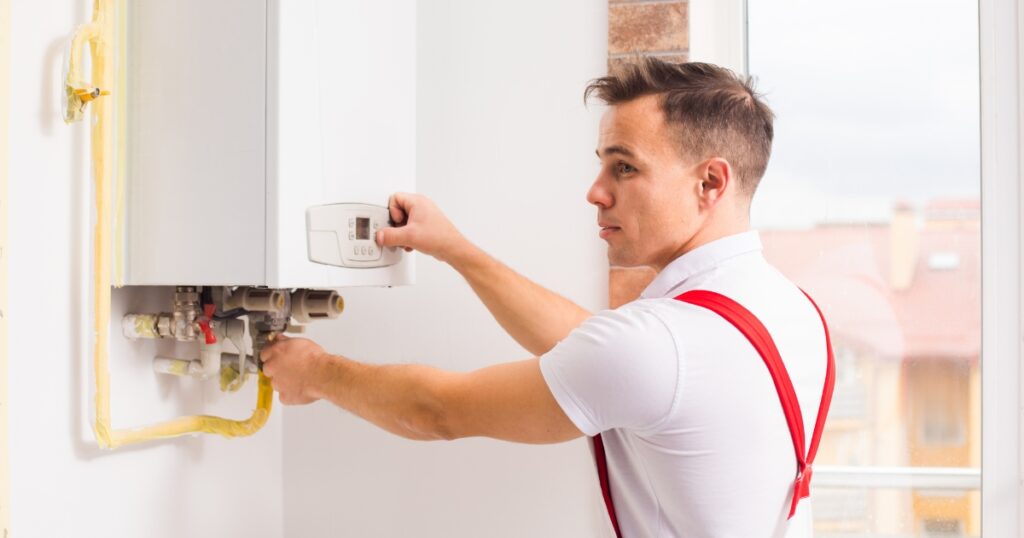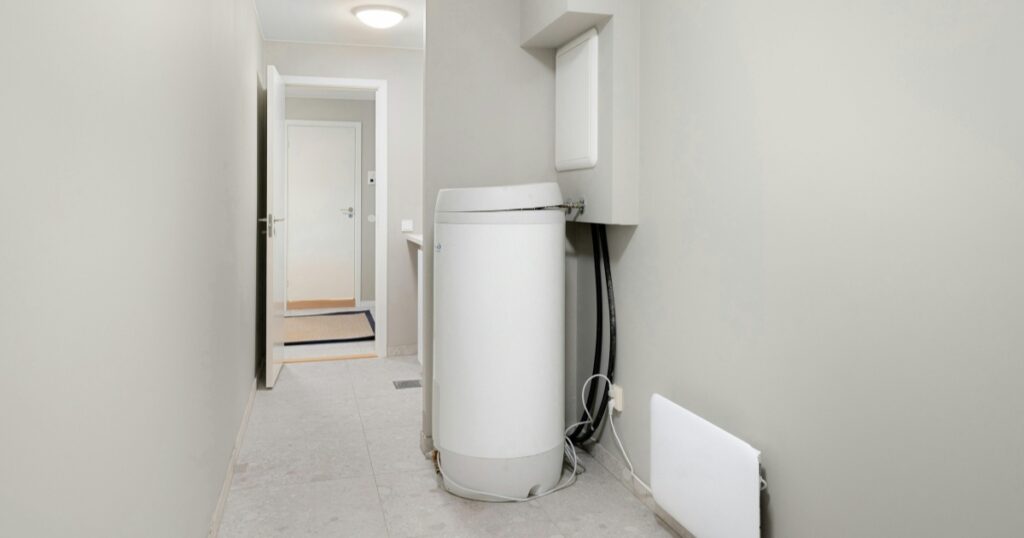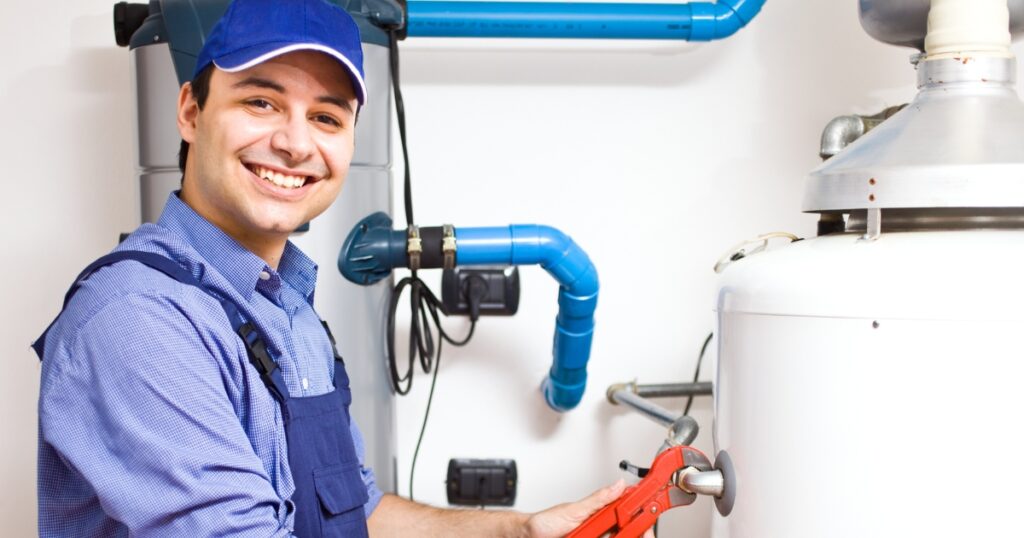Ever found yourself scratching your head over the idea of switching to a tankless hot water system because you’re worried about potential repair hassles? We totally get it. It can be a bit like trying to decide whether to switch from footy to cricket mid-season.
It’s true that compared with traditional heaters, tankless systems do have more components – which could mean additional upkeep. But don’t worry! We’ve put on our detective hats and done some rigorous research for you.
This blog post is here as your helpful guide, answering all the curly questions and key considerations when changing over to a tankless system for your hot water needs.
By the time you finish reading this post, we reckon you’ll feel as informed and confident as an AFL coach choosing his Grand Final team! Ready? Let’s delve into it together.
Key Takeaways
- Consider temperature rise and flow rate to ensure your new tankless hot water system can handle your desired temperature and simultaneous usage needs.
- Factor in maintenance and repair costs when upgrading to a tankless system, as they may be higher due to the complexity of these systems.
- Take advantage of the space-saving design of tankless water heaters, which are much smaller and more compact than traditional tanks.
Key Considerations When Upgrading to a Tankless Hot Water System
When upgrading to a tankless hot water system, it is important to consider factors such as temperature rise and flow rate, maintenance and repairs, space considerations, the type of heater, and the cost of installation.

Temperature rise and flow rate
Taking into account temperature rise and flow rate is integral in the transition to a tankless water heater.
Temperature rise refers to how much the heater needs to increase the incoming water’s temperature, whereas flow rate measures how much hot water your home requires during peak usage.
So, it’s vital for us as homeowners to understand these elements before making such an upgrade. If our desired temperature rise exceeds what our new system can handle, we could find ourselves with lukewarm showers! Similarly, if we underestimate our home’s demand for simultaneous hot water use—say someone’s doing dishes while another person showers—we might also end up disappointed by the performance of even a top-of-the-line unit.
Our primary goal should be getting a system that balances both these factors effectively!
Maintenance and repairs
Maintaining and repairing a tankless water heater is an important consideration when upgrading to this type of system. Unlike traditional water heaters, tankless models have more parts that may require additional maintenance and repair costs.
It’s essential to factor in these potential expenses when calculating the overall cost of the upgrade. Proper installation is also crucial for ensuring the longevity and efficiency of your tankless water heater.
Taking into account factors such as fuel type, climate, and local building codes will help ensure a successful installation process. Regular maintenance checks can prevent issues like leaks or inconsistent water temperatures, providing you with continuous hot water whenever you need it.
Space considerations
When upgrading to a tankless hot water system, it’s important to take space considerations into account. Unlike traditional tank water heaters, which can be quite large and take up a significant amount of space, tankless water heaters are much smaller and more compact.
This means that they can be installed in tight spaces or even mounted on walls, freeing up valuable floor space in your home. So if you’re looking to maximise the available space in your utility room or basement, switching to a tankless hot water system is definitely worth considering.
Type of heater
Different types of tankless water heaters are available for homeowners to choose from. These include electric and gas-powered models. Electric tankless water heaters are generally more affordable upfront, with prices ranging from $90 to $900, depending on the brand and features.
On the other hand, gas-powered tankless water heaters tend to have higher installation costs due to the need for ventilation and gas line connections. When considering which type of heater to choose, it is important to evaluate factors such as fuel availability in your area, energy efficiency ratings, and your household’s hot water demands.
Cost of installation
Installing a tankless water heater can come with additional costs compared to a traditional water heater. While the price of tankless electric heaters can range from $90 to $900, the installation costs may be higher than simply replacing a traditional tank.
It’s important to consider these upfront expenses when deciding to upgrade, as they can impact the overall cost of installing a tankless hot water system.
Pros and Cons of Tankless Water Heaters
Tankless water heaters have both advantages and disadvantages. One of the main benefits is that they provide hot water on demand, eliminating the need for a storage tank and ensuring you never run out of hot water.
Additionally, tankless water heaters are more energy-efficient than traditional models, as they only heat water when it’s needed. This can lead to significant cost savings on your utility bills.
However, there are some drawbacks to consider. The initial cost of purchasing and installing a tankless water heater is generally higher than that of a traditional model. In addition, the maintenance and repair costs may be higher due to the complexity of these systems.
Tankless water heaters also have limited output capacity, which means they may struggle to meet the demands of large households or multiple simultaneous hot water users.
Overall, before making the switch to a tankless water heater, it’s essential to weigh both the pros and cons carefully. Consider factors such as your household size, hot water usage patterns, budget constraints, and long-term energy efficiency goals in order to make an informed decision about whether a tankless system is right for you.

Types of Tankless Water Heaters
Tankless water heaters come in different types to suit the needs of various households. The two main types are electric tankless water heaters and gas tankless water heaters. Electric tankless water heaters are popular because of their ease of installation and flexibility. They are generally more compact and can be installed in smaller spaces, such as under sinks or in closets.
However, they may have limitations when it comes to providing hot water for larger households with high demand.
On the other hand, gas tankless water heaters are known for their high efficiency and ability to handle heavy hot water loads. They require a natural gas or propane fuel source and proper venting for safe operation.
Gas tankless water heaters are often chosen for larger homes where multiple faucets might be used simultaneously.
It’s important to consider your household’s hot water needs and budget when choosing between electric or gas tankless water heater options. Additionally, consulting with a professional plumber can help determine the best type of tankless water heater for your specific requirements.
Benefits of Upgrading to a Tankless Hot Water System
Space-saving design. Say goodbye to bulky water tanks and hello to a sleek, compact tankless system that takes up minimal space in your home.
And there’s more! Keep reading to discover the other amazing benefits of upgrading to a tankless hot water system.
Space-saving design
Tankless hot water systems offer a space-saving design that can be beneficial for homeowners. Unlike traditional tank water heaters, which take up a significant amount of space, tankless units are compact and can easily fit in smaller areas.
This is especially advantageous for homes with limited space or those looking to maximise their storage options. With a tankless hot water system, you can have all the benefits of continuous hot water without sacrificing valuable square footage in your home.
Continuous hot water supply
A tankless hot water system provides the benefit of a continuous supply of hot water. Unlike traditional tank heaters that can run out of hot water, a tankless system heats water on demand, ensuring you always have access to hot water when you need it.
This is especially convenient for households with multiple occupants or during peak usage times. With a tankless system, there’s no more waiting for the tank to refill and reheat. You can enjoy uninterrupted showers, baths, and laundry without worrying about running out of hot water.
Tankless systems also offer precise temperature control, allowing you to set and maintain your desired level of comfort consistently throughout use. So whether it’s morning showers or late-night dishwashing, you can count on a constant supply of hot water with a tankless upgrade.
Energy efficiency
Switching to a tankless hot water system can significantly improve the energy efficiency of your home. Unlike traditional water heaters that constantly heat and store water, tankless systems only heat water as needed, resulting in less energy waste.
According to experts, tankless water heaters can be up to 30% more energy-efficient than their conventional counterparts. This means lower utility bills and reduced environmental impact.
With an emphasis on sustainability and cost savings, upgrading to a tankless hot water system is an excellent choice for homeowners looking to increase their overall energy efficiency.
Longer lifespan
Tankless water heaters have a longer lifespan compared to traditional tank water heaters. This means that once you upgrade to a tankless system, you won’t need to worry about replacing it as frequently.
With proper maintenance and occasional repairs, your tankless water heater can last up to 20 years or more. This extended lifespan not only saves you money in the long run but also provides peace of mind knowing that your hot water needs will be met for many years without the hassle of frequent replacements.
Reduced risk of water damage
With a tankless hot water system, you can enjoy a reduced risk of water damage in your home. Unlike traditional tanks that can leak or burst, tankless water heaters have a lower chance of causing any significant water damage.
This is because they don’t store large amounts of hot water that could potentially flood your home if something goes wrong. By upgrading to a tankless hot water system, you can have peace of mind knowing that the risk of costly repairs due to water damage is minimised.
So, say goodbye to worries about leaks and floods and hello to the convenience and reliability of a tankless hot water system.
Upgrade Your Hot Water System Now
When upgrading to a tankless hot water system, it’s crucial to consider the repair and maintenance factors. These systems may require additional costs and more frequent repairs compared to traditional water heaters.
Proper installation, sizing, and regular maintenance are key to ensuring a smooth transition and enjoying the benefits of continuous hot water supply and energy efficiency. So, before making the switch, evaluate these repair considerations carefully for a hassle-free experience with your tankless hot water system.






